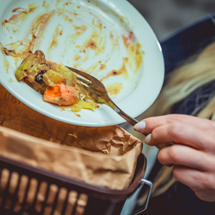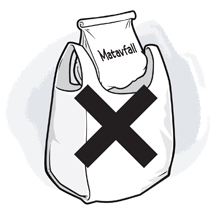How to handle different types of waste
Your waste might contain hazardous substances as well as valuable substances. It is therefore important that all waste is put in the right place so it can be dealt with in the best way. Where you leave your waste depends on which waste subscription you have. This information is intended to help you if you have any questions regarding the new waste system and how to sort in the new bins.
Food waste
Put left-overs from cooking or eating inside a brown paper bag intended for food waste. When the bag is filled up to the marked line, place the bag in the compartment intended for food waste in the sorting bin.
Peel from fruits and vegetables, leftovers of meat, fish, seafood, bread, pasta and rice. Coffee grounds, coffee filters, tea grounds and tea bags are examples of what you should sort as food waste.

Instructions:
- Use only paper bags intended for food waste. The bags are made of a degradable material, and is also adapted to resist moist food waste, which means that they don't get soaked easily, the bags are made to dry quickly as well.
- Unwrap the food waste bag and place it in the holder. Fold down an edge at the top, so you have a dry part to seal it with.
- Remove any plastic and other packaging around the food waste before putting it in the bag.
- Allow wet food debris to drain before putting them in the bag.
- When the bag is filled up to the marked line, you can roll it up and put it in the compartment/container intended for food waste.
- Replace the bag with a new one after 2 to 3 days, even if it's not filled up to the marked line.
- Roll up the bag tightly before you place the bag in the compartment for food waste in bin number 2.
New food waste bags
When you are out of paper bags intended for food waste, collect new ones in most of the local grocery stores or at one of our recycling Centres. The bags are free of charge.
Pick up new food waste bags here:
- Nytäppans återvinningscentral (recycling Centre), Smedjebacken
- ICA Supermarket, Smedjebacken
- Coop, Smedjebacken
- ICA Nära Bärkehallen, Söderbärke
- Nors återvinningscentral, Söderbärke (recycling Centre)
- Björnhyttans återvinningscentral, Ludvika (recycling Centre)
- ICA Kvantum, Ludvika
- Stora Coop, Ludvika
- Lidl, Ludvika
- Willys, Ludvika
- Coop Ludvika Gård, Ludvika
- Hemköp, Ludvika
- Coop, Fredriksberg
- Fredriksbergs återvinningscentral (recycling Centre)
- ICA Nära, Grangärde
- Coop, Grängesberg
- ICA Nära, Grängesberg
- Coop, Sunnansjö
What happens with your food waste?
The separated food waste will be transported to a pre-treatment facility in Borlänge, just like the food waste from all the other municipalities in Dalarna.
The food waste is then converted into biogas and bio fertilizer.
Biogas is an environmentally friendly fuel that does not contribute to the greenhouse effect.
When food waste and other organic waste are converted into biogas, digestate is also produced, a nutritional product used to fertilize fields. By sorting out food waste the energy and nutritional content of the waste is optimally utilized.
Packaging, newspapers and recyclable paper
Packaging is the wrapping material around a consumer item that serves to contain, identify, describe, protect, display, promote and otherwise make the product marketable and keep it clean.
Packaging as well as newspapers and recyclable paper are used as raw material in the manufacturing of new products. When the material is re-used, we save a large amount of raw materials and energy in comparison to use new raw materials.
You sort out newspapers, recyclable paper and packaging of plastic, metal, coloured glass, clear glass and paper, and leave it in the different compartments in the sorting bin.
Residual waste
Residual waste is what remains after you have sorted out food waste, packaging, newspapers and recyclable paper as well as hazardous waste. Examples of residual waste is: diapers, pads, toothbrushes, dish cloths and cotton swabs.
Put residual waste in a plastic bag. When the bag is full, leave it in the compartment intended for residual waste in your sorting bin or container. Make sure the bag is properly sealed before putting it in the compartment intended for residual waste in the sorting bin.
The residual waste will be transformed into energy at a combustion plant.
Hazardous waste
All waste that is hazardous to humans and our environment is classified as "hazardous waste" and should never be placed in the bag for residual waste, neither should you pouring it into the drain. Sort out what you suspect is dangerous or harmful and leave it at a Recycling Centre.
The hazardous waste is taken care of and destroyed, recycled or stored in a way that does not cause damage to the environment or humans.
Electrical items
Electrical waste, such as appliances, televisions, computers, screwdrivers, drillers, coffee makers and fluorescent lamps, at a Recycling Centre. Many products have built-in batteries. The entire product must then be submitted. Stores selling electronic gadgets may also receive electrical waste.
If you have the subscription form Standard you can store bulbs, smaller electrical waste and batteries in the box for smaller electrical waste.
Bulky waste
Waste that is bulky, large or heavy is called bulky waste such as furniture, carpets, mattresses and scrap metal. It can also be garden waste and non-recyclable waste, such as tiles, porcelain, bricks, ceramics and concrete. All such waste should be submitted at a Recycling Centre.
Recycling Stations
There are 16 recycling stations in Smedjebacken municipality. At the stations you sort out empty packaging of plastic, paper and metal, clear glass, coloured glass, newspapers and recyclable paper and leave it in the different containers.
Recycling Centres
In Smedjebacken and Ludvika municipalities, there are four Recycling Centres: Nytäppan, Nor, Björnhyttan and Fredriksberg. Here you leave sorted bulky waste, hazardous waste, electrical waste and garden waste.
Recycle other stuff as well
Do you have clothes, furniture or other used items that you no longer need or want? By donating, exchanging or selling your things instead of throwing them away, they can come in handy for someone else, at the same time you are doing the environment a favour as well.
At Nytäppan Recycling Centre there is a recycling store, where you can leave your unwanted gadgets.
You can also leave worn but clean clothing, shoes and household textiles to the aid organization Human Bridge. Their containers can be found at our Recycling Centres and at some of the Recycling Stations.
Cooking oil and grease
Avoid to pour cooking oil and grease into the drain, since that can cause clogging in the pipes.
Instead:
Wipe the frying pan with paper towels and toss it in the bag for food waste. Smaller amounts of cooking grease or oil, can be poured into a plastic bottle or plastic jar and put it in the regular garbage bag for residual waste.
Leave larger amounts of oil and fat at a recycling centre. Submitted fat is recycled.
Tip
Paper towels and used napkins can be placed in the bag for food waste, the paper soak up liquid and keeps the bag dry.
Important!
Use the food waste bag made of paper to put your food waste in. Don't put your food waste loose inside the sorting vessel/container, and never place it inside plastic bags.

